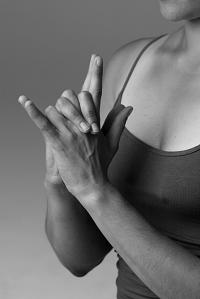Yoga Breathing Helps Patients Receiving Chemotherapy Improve their Quality of Life

When we think of yoga, both the physical postures and the controlled breathing may come to mind. Yoga breathing techniques, called pranayama, work by acting as both a physical practice and a form of meditation.
Patients with cancer who receive chemotherapy often suffer a host of debilitating treatment side effects including fatigue, sleep disturbances, and other physical and mental side effects. Anand Dhruva, MD, Assistant Clinical Professor of Medicine on the Hematology-Oncology faculty at UCSF, and colleagues assessed the feasibility of practicing yoga breathing among patients receiving chemotherapy. This work was funded in part by a grant* from the National Center for Complementary and Alternative Medicine, part of the National Institutes of Health. Dr Dhruva's study tested breathing techniques to determine if they alleviated some common chemotherapy-associated symptoms such as fatigue, sleep disturbance, stress, anxiety and depression, as well as measuring overall improvement of patients' quality of life.
The results of this small pilot study of 16 participants were recently published in the Journal of Alternative and Complementary Medicine and will set the stage for a larger randomized controlled trial. The patients were randomized to a treatment group of a pranayama breathing intervention which consisted of a 60-minute class once a week for seven weeks and twice daily home practice totaling 20-30 minutes per day, along with their usual care during two consecutive chemotherapy cycles. The control group received only usual care during the initial cycle of chemotherapy and the pranayama intervention along with usual care during the second cycle of chemotherapy.
Participants in the breathing group cycled through four different breathing techniques which were initially taught by certified yoga instructors. Techniques included breath observation, in which participants focused on their natural breath with the goal of maintaining continual awareness. A second type of breathing, called ujjayi, focused on abdominal breathing of deep and slow rhythmic inhalation and exhalation. A third technique of forced abdominal exhalation, kapalabhati pranayama, included the techniques of inhaling gently, retaining the air briefly and then exhaling forcefully. The last breathing technique of alternate nostril breathing, nadi shodhana, involved moving air through alternate nostrils by placing the finger in a hand position to block each nostril one at a time.
Symptoms and quality of life measurements were assessed via self-report questionnaires and assessments and were obtained at baseline, between the first and second round of chemotherapy, and at the end of the study, for both groups. Measurements included the Piper Fatigue Scale, the General Sleep Disturbance Scale (GSDS), the Hospital Anxiety and Depression Scale (HADS), the Perceived Stress Scale and the SF-12 used to measure quality of life (QOL). Participants also kept a daily diary recording their time spent practicing pranayama.
Results showed that participants in the treatment group and control group averaged 3.2 hours and 2.4 hours (during their second chemo cycle) of home practice per week, respectively. There were no statistically significant between-group differences in any of the baseline symptoms of QOL scores. The breathing treatment group showed gradual improvement s in their scores for the measures of stress, sleep disturbance, anxiety, and mental quality of life at both the mid-point and endpoint of the study. Fatigue and depression initially worsened in the treatment group during the first chemo cycle, followed by improvements in the second cycle. For the measures of sleep disturbance, anxiety, depression and mental quality of life, the control group worsened during the control phase and improved during the treatment phase. Interestingly, any increase in the amount of yoga practice (at home or in class) was associated with improvement in symptoms and QOL. This was consistent across all measures. Statistically significant improvements in sleep disturbance and anxiety were seen with increased yoga practice. Study authors note, “Overall, these data suggest that a longer or more intensive yoga breathing intervention could have greater beneficial effects on symptoms and QOL.”
Also interesting to note is the primary efficacy endpoint of fatigue showed no difference between groups and authors speculated that breathing has no effect on fatigue and/or the small sample size led to a high variability of this symptom in the participants. A lack of effect on depression was also attributed to the low sample size, low levels of depression in the sample, and/or lack of effect of yoga breathing on depression. Limitations of this study included the small sample size as well as the reliance on self reported measures. The authors noted that to their knowledge no other study has focused exclusively on yoga breathing and with the ease of practice of yoga breathing and the lack of adverse side effects it is an attractive intervention for further study in the cancer patient population.
For more information about this study, please view the original article: http://www.ncbi.nlm.nih.gov/pubmed/22525009
* 5K23AT005340-05





